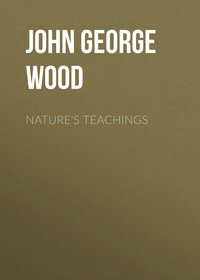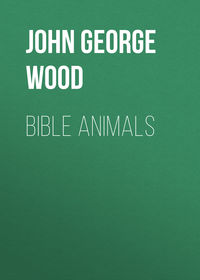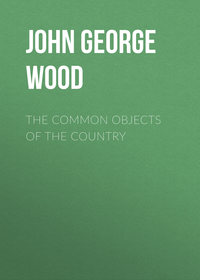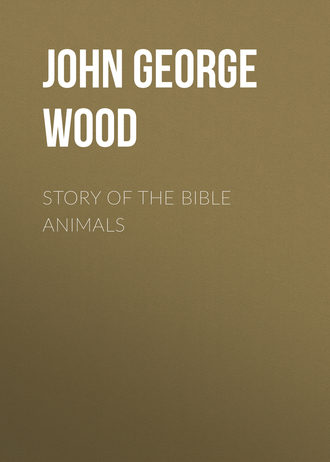 полная версия
полная версияStory of the Bible Animals
There are few animals more wary than the Beden, and even the chamois of the Alps does not exercise the finest qualities of a hunter more than does the Beden of Palestine. It is gifted with very keen eyes, which can discern the approach of an enemy long before its grey coat and curved horns can be distinguished from the stones and gnarled boughs of the mountain side. And, even if the enemy be not within range of the animal's sight, its nostrils are so keen that it can detect a man by scent alone at a considerable distance. Like all gregarious animals, the Beden insures the safety of the flock by stationing sentries, which are posted on places that command the whole surrounding country, and to deceive the watchful senses of these wary guardians tests all the qualities of the hunter.
The dawn of day is the time that is generally chosen for approaching a herd, because the animals are then feeding, and if the hunter can manage to approach them against the wind, he may chance to come within range. Should however the wind change its direction, he may quietly walk home again, for at the first breath of the tainted gale the sentinels utter their shrill whistle of alarm, and the whole party dash off with a speed that renders pursuit useless.
The horns of the Beden are of very great size, and from their bold curves, with the large rings and ridges which cover their front, are remarkably handsome objects. In their own country they are in great request as handles to knives, and even in England they may be occasionally seen serving as handles to carving-knives and forks.
As to the word Ako, which occurs in Deut. xiv. 5, together with other animals, and is rendered as "Wild Goat," there is so much doubt about the correct translation that I can do no more than mention that the Jewish Bible follows our authorized edition in translating Ako as Wild Goat, but adds the doubtful mark to the word.

THE DEER
The Hart and Hind of Scripture—Species of Deer existing in Palestine—Earliest mention of the Hind—The Hart classed among the clean animals—Passages alluding to its speed—Care of the mother for her young, and her custom of secreting it—Tameable character of the Deer.
We now come to the Deer which are mentioned in Scripture. There are not many passages in which they are mentioned, and one of them is rather doubtful, as we shall see when we come to it.
There is no doubt that the two words Hart and Hind (in the Hebrew Ayzal and Ayzalah) represent Deer of some kind, and the question is to find out what kind of Deer is signified by these words. I think that we may safely determine that no particular species is meant, but that under the word Ayzal are comprehended any kinds of Deer that inhabit Palestine, and were likely to be known to those to whom the earlier Scriptures were addressed. That some kind of Deer was plentiful is evident from the references which are made to it, and specially by the familiar word Ajala or Ayala, as it is pronounced, which signifies the Deer-ground or pasture. But the attempt to discriminate between one species and another is simply impossible, and the more careful the search the more impracticable the task appears.
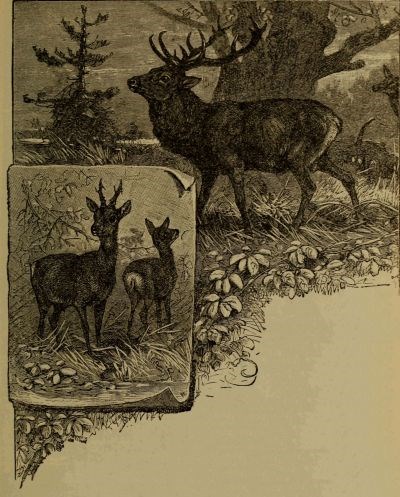
RED DEER.
As far as can be ascertained, at least two kinds of Deer inhabited Palestine in the earlier days of the Jewish history, one belonging to the division which is known by its branched horns, and the other to that in which the horns are flat or palmated over the tips. Examples of both kinds are familiar to us under the titles of the Red Deer and the Fallow Deer, and it is tolerably certain that both these animals were formerly found in Palestine, or that at all events the Deer which did exist there were so closely allied to them as to be mere varieties occasioned by the different conditions in which they were placed.
We will now proceed to the various passages in which the Hart and Hind are mentioned in the Bible.

FALLOW-DEER, OR HIND OF SCRIPTURE.
As might be expected, we come upon it among the number of the beasts which divided the hoof and chewed the cud, and were specially indicated as fit for food; see Deut. xii. 15: "Notwithstanding thou mayest kill and eat flesh in all thy gates, … the unclean and the clean may eat thereof, as of the roebuck, and as of the hart."
There is, however, an earlier mention of the word in Gen. xlix. 21. It occurs in that splendid series of imagery in which Jacob blesses his sons, and prophesies their future, each image serving ever afterwards as the emblem of the tribe: "Naphtali is a hind let loose: he giveth goodly words;"—or, according to the Jewish Bible, "Naphtali is a hind sent forth: he giveth sayings of pleasantness." Now, such an image as this would never have been used, had not the spectacle of the "hind let loose" been perfectly familiar to the eyes both of the dying patriarch and his hearers, and equally so with the lion, the ass, the vine, the serpent, and other objects used emblematically in the same prophetic poem.
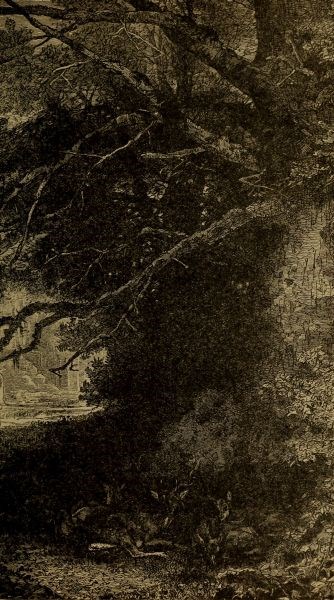
A QUIET SPOT.
The excellence of the Hart's flesh is shown by its occurrence among the animals used for King Solomon's table: see 1 Kings iv. 23, a passage which has been quoted several times, and therefore need only be mentioned.
Allusion is made to the speed and agility of the Deer in several passages. See, for example, Isa. xxxv. 6: "Then shall the lame man leap as an hart, and the tongue of the dumb sing." Again, in 2 Sam. xxii. 33, 34: "God is my strength and power: and He maketh my way perfect.
"He maketh my feet like hinds' feet: and setteth me upon my high places."
Nearly four hundred years afterwards we find Habakkuk using precisely the same image, evidently quoting David's Psalm of Thanksgiving:—"Yet I will rejoice in the Lord, I will joy in the God of my salvation.
"The Lord God is my strength, and He will make my feet like hinds' feet, and He will make me to walk upon mine high places." (iii. 18, 19.)
A passage of a similar character may be found in Solomon's Song, ii. 8, 9: "The voice of my beloved! behold, he cometh leaping upon the mountains, skipping upon the hills.
"My beloved is like a roe or a young hart."
There is one passage in the Psalms which is familiar to us in many ways, and not the least in that it has been chosen as the text for so many well-known anthems. "As the hart panteth after the water-brooks, so panteth my soul after Thee, O God.
"My soul thirsteth for God, for the living God: when shall I come and appear before God?" (Ps. xlii. 1, 2.)
Beautiful as this passage is, it cannot be fully understood without the context.
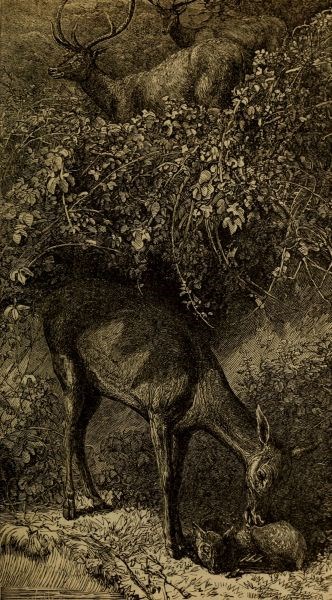
RED DEER AND FAWN.
David wrote this psalm before he had risen to royal power, and while he was fleeing from his enemies from place to place, and seeking an uncertain shelter in the rock-caves. In verse 6 he enumerates some of the spots in which he has been forced to reside, far away from the altar, the priests, and the sacrifice. He has been hunted about from place to place by his enemies as a stag is hunted by the hounds, and his very soul thirsted for the distant Tabernacle, in which the Shekinah, the visible presence of God, rested on the mercy-seat between the golden cherubim.
Wild and unsettled as was the early life of David, this was ever the reigning thought in his mind, and there is scarcely a psalm that he wrote in which we do not find some allusion to the visible presence of God among men. No matter what might be the troubles through which he had to pass, even though he trod the valley of the shadow of death, the thought of his God was soothing as water to the hunted stag, and in that thought he ever found repose. Through all his many trials and adversities, through his deep remorse for his sins, through his wounded paternal affections, through his success and prosperity, that one thought is the ruling power. He begins his career with it when he opposed Goliath: "Thou comest to me with a sword, and with a spear, and with a shield: but I come to thee in the name of the Lord of hosts, the God of the armies of Israel." He closes his career with the same thought, and, in the "last words" that are recorded, he charged his son to keep the commandments of the Lord, that he might do wisely all that he did.
We now come to another point in the Deer's character; namely, the watchful care of the mother over her young. She always retires to some secret place when she instinctively knows that the birth is at hand, and she hides it from all eyes until it is able to take care of itself. By some strange instinct, the little one, almost as soon as it is born, is able to comprehend the signals of its mother, and there is an instance, well known to naturalists, where a newly-born Deer, hardly an hour old, crouched low to the earth in obedience to a light tap on its shoulder from its mother's hoof. She, with the intense watchfulness of her kind, had seen a possible danger, and so warned her young one to hide itself.

THE LEADER OF THE HERD.
There is scarcely any animal so watchful as the female Deer, as all hunters know by practical experience. It is comparatively easy to deceive the stag who leads the herd, but to evade the eyes and ears of the hinds is a very different business, and taxes all the resources of a practised hunter. If they take such care of the herd in general, it may be imagined that their watchfulness would be multiplied tenfold when the object of their anxiety is their own young.
It is in allusion to this well-known characteristic that a passage in the Book of Job refers: "Knowest thou the time when the wild goats of the rock bring forth? or canst thou mark when the hinds do calve?" (xxxix. 1.) A similar image is used in Psa. xxix. 9. After enumerating the wonders that are done by the voice of the Lord, the thunders and rain torrents, the devastating tempests, the forked lightning, and the earthquake "that shaketh the wilderness of Kadesh," the Psalmist proceeds: "The voice of the Lord maketh the hinds to calve, and discovereth the forests,"—this being as mysterious to the writer as the more conspicuous wonders which he had previously mentioned.
So familiar to the Hebrews was the watchful care which the female Deer exercised over her young, that it forms the subject of a powerful image in one of Jeremiah's mournful prophecies: "Yea, the hind also calved in the field, and forsook it, because there was no grass." (xiv. 5.) To those who understand the habits of the animal, this is a most telling and picturesque image. In the first place, the Hind, a wild animal that could find food where less active creatures would starve, was reduced to such straits that she was obliged to remain in the fields at the time when her young was born, instead of retiring to some sheltered spot, according to her custom. And when it was born, instead of nurturing it carefully, according to the natural maternal instinct, she was forced from sheer hunger to abandon it in order to find a sufficiency of food for herself.
That the Deer could be tamed, and its naturally affectionate disposition cultivated, is evident from a passage in the Proverbs (v. 18, 19): "Let thy fountain be blessed: and rejoice with the wife of thy youth. Let her be as the loving hind and pleasant roe."
We might naturally expect that the Rabbinical writers would have much to say on the subject of the Hart and Hind. Among much that is irrelevant to the object of the present work there are a few passages that deserve mention. Alluding to the annual shedding of the Deer's horns, there is a proverb respecting one who ventures his money too freely in trade, that "he has hung it on the stag's horns," meaning thereby that he will never see it again. It is remarkable that in Western Africa there is a proverb of a similar character, the imprudent merchant being told to look for his money in the place where Deer shed their horns.
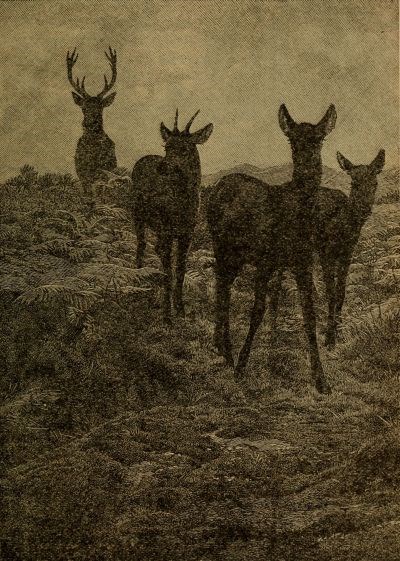
THE WATCHFUL DOE.

A KNEELING CAMEL.
THE CAMEL
CHAPTER I
The two species of Camel, and the mode of distinguishing them—Value of the Camel in the East—Thirst-enduring capability—The hump, and its use to the animal—The Camel as a beast of draught and burden—How the Camel is laden—Camels for riding—Difficulty of sitting a Camel—A rough-paced steed—Method of guiding the Camel—The swift dromedary—Young Camels and their appearance—The deserted Camel.
Before treating of the Scriptural references to the Camel, it will be as well to clear the ground by noticing that two distinct species of Camel are known to zoologists; namely, the common Camel (Camelus dromedarius), which has one hump, and the Bactrian Camel (Camelus Bactrianus), which has two of these curious projections. There is a popular but erroneous idea that the dromedary and the Camel are two distinct animals, the latter being distinguished by its huge hump, whereas the fact is, that the dromedary is simply a lighter and more valuable breed of the one-humped Camel of Arabia, the two-humped Bactrian Camel being altogether a different animal, inhabiting Central Asia, Thibet, and China.
The Camel is still one of the most valued animals that inhabit Palestine, and in former times it played a part in Jewish history scarcely inferior to that of the ox or sheep. We shall, therefore, devote some space to it.
In some parts of the land it even exceeded in value the sheep, and was infinitely more useful than the goat. At the very beginning of Jewish history we read of this animal, and it is mentioned in the New Testament nearly two thousand years after we meet with it in the Book of Genesis. The earliest mention of the Camel occurs in Gen. xii. 16, where is related the journey of Abram: "He had sheep, and oxen, and he-asses, and men-servants, and maid-servants, and she-asses, and camels."
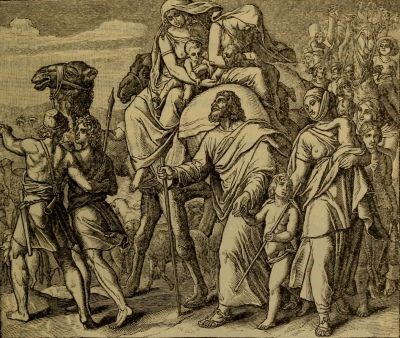
JACOB LEAVES LABAN AND RETURNS TO CANAAN WITH HIS CAMELS, SHEEP, AND CATTLE.
Belonging, as he did, to the nomad race which lives almost wholly on the produce of their herds, Abram needed Camels, not only for their milk, and, for all we know, for their flesh, but for their extreme use as beasts of burden, without which he could never have travelled over that wild and pathless land. The whole of Abram's outer life was exactly that of a Bedouin sheikh of the present day, in whom we find reproduced the habits, the tone of thought, and the very verbiage of the ancient Scriptures.
Many years afterwards, when the son of his old age was desirous of marrying a wife of his own kindred, we find that he sent his trusted servants with ten of his Camels to Mesopotamia, and it was by the offering of water to these Camels, that Rebekah was selected as Isaac's wife (see Gen. xxiv. 10, 19). In after days, when Jacob was about to leave Laban, these animals are mentioned as an important part of his wealth: "And the man increased exceedingly, and had much cattle, and maid-servants, and men-servants, and camels, and asses" (Gen. xxx. 43).
It is thought worthy of mention in the sacred narrative that Job had three thousand, and afterwards six thousand Camels (Job i. 3, and xlii. 12); that the Midianites and Amalekites possessed camels without number, as the sand by the seaside.
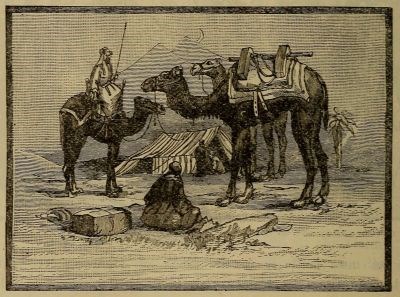
A CAMP IN THE DESERT.
They were valuable enough to be sent as presents from one potentate to another. For example, when Jacob went to meet Esau, he gave as his present two hundred and twenty sheep, the same number of goats, fifty oxen, thirty asses, and sixty camels, i.e. thirty mothers, each with her calf. They were important enough to be guarded by men of position. In 1 Chron. xxvii. 30, we find that the charge of David's Camels was confided to one of his officers, Obil the Ishmaelite, who, from his origin, might be supposed to be skilful in the management of these animals. Bochart, however, conjectures that the word Obil ought to be read as Abal, i.e. the camel-keeper, and that the passage would therefore read as follows: "Over the camels was an Ishmaelitish camel-keeper."
We will now proceed to the uses of the Camel, and first take it in the light of food.
By the Mosaic law, the Camel was a forbidden animal, because it did not divide the hoof, although it chewed the cud. Yet, although the Jews might not eat its flesh, they probably used the milk for food, as they do at the present day. No distinct Scriptural reference is made to the milk of the Camel; but, as the Jews of the present day are quite as fastidious as their ancestors in keeping the Mosaic law, we are justified in concluding that, although they would not eat the flesh of the animal, they drank its milk. At the present time, the milk is used, like that of the sheep, goat, and cow, both in a fresh and curdled state, the latter being generally preferred to the former. A kind of cheese is made from it, but is not much to the taste of the European traveller, on account of the quantity of salt which is put in it. Butter is churned in a very simple manner, the fresh milk being poured into a skin bag, and the bag beaten with a stick until the butter makes its appearance.
That it was really used in the patriarchal times is evident by the passage which has already been mentioned, where Jacob is related to have brought as a present to his brother Esau thirty milch Camels, together with their young. So decided a stress would certainly not have been laid upon the fact that the animals were milch Camels unless the milk were intended for use.
Perhaps the use of the Camel's milk might be justified by saying that the prohibition extended only to eating and not to drinking, and that therefore the milk might be used though the flesh was prohibited.
There was another mode in which the Camel might be used by travellers to sustain life.
The reader is probably aware that, even in the burning climate in which it dwells, the Camel is able to go for a long time without drinking,—not that it requires less liquid nourishment than other animals, but that it is able, by means of its internal construction, to imbibe at one draught a quantity of water which will last for a considerable time. It is furnished with a series of cells, into which the water runs as fast as it is drunk, and in which it can be kept for some time without losing its life-preserving qualities. As much as twenty gallons have been imbibed by a Camel at one draught, and this amount will serve it for several days, as it has the power of consuming by degrees the water which it has drunk in a few minutes.
This curious power of the Camel has often proved to be the salvation of its owner. It has often happened that, when travellers have been passing over the desert, their supply of water has been exhausted, partly by the travellers and partly by the burning heat which causes it to evaporate through the pores of the goat-skin bottle in which it was carried. Then the next well, where they had intended to refill their skins and refresh themselves, has proved dry, and the whole party seemed doomed to die of thirst.
Under these circumstances, only one chance of escape is left them. They kill a Camel, and from its stomach they procure water enough to sustain life for a little longer, and perhaps to enable them to reach a well or fountain in which water still remains. The water which is thus obtained is unaltered, except by a greenish hue, the result of mixing with the remains of herbage in the cells. It is, of course, very disagreeable, but those who are dying from thirst cannot afford to be fastidious, and to them the water is a most delicious draught.
It is rather curious that, if any of the water which is taken out of a dead Camel can be kept for a few days, both the green hue and the unpleasant flavour disappear, and the water becomes fresh, clear, and limpid. So wonderfully well do the internal cells preserve the water, that after a Camel has been dead for ten days—and in that hot climate ten days after death are equal to a month here—the water within it has been quite pure and drinkable.
Many persons believe in the popular though erroneous idea that the Camel does not require as much water as ordinary animals. He will see, however, from the foregoing account that it needs quite as much water as the horse or the ox, but that it possesses the capability of taking in at one time as much as either of these animals would drink in several days. So far from being independent of water, there is no animal that requires it more, or displays a stronger desire for it. A thirsty Camel possesses the power of scenting water at a very great distance, and, when it does so, its instincts conquer its education, and it goes off at full speed towards the spot, wholly ignoring its rider or driver. Many a desert spring has been discovered, and many a life saved, by this wonderful instinct, the animal having scented the distant water when its rider had lost all hope, and was resigning himself to that terrible end, the death by thirst. The sacred Zemzem fountain at Mecca was discovered by two thirsty Camels.
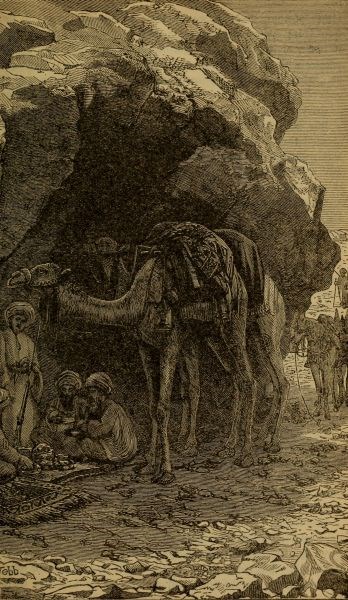
A GRATEFUL SHADE.
Except by the Jews, the flesh of the Camel is eaten throughout Palestine and the neighbouring countries, and is looked upon as a great luxury. The Arab, for example, can scarcely have a greater treat than a Camel-feast, and looks forward to it in a state of wonderful excitement. He is so impatient, that scarcely is the animal dead before it is skinned, cut up, and the various parts prepared for cooking.
To European palates the flesh of the Camel is rather unpleasant, being tough, stringy, and without much flavour. The fatty hump is universally considered as the best part of the animal, and is always offered to the chief among the guests, just as the North American Indian offers the hump of the bison to the most important man in the assembly. The heart and the tongue, however, are always eatable, and, however old a Camel may be, these parts can be cooked and eaten without fear.
The hump, or "bunch" as it is called in the Bible, has no connexion with the spine, and is a supplementary growth, which varies in size, not only in the species, but in the individual. It is analogous to the hump upon the shoulders of the American bison and the Indian zebra, and in the best-bred Camels it is the smallest though the finest and most elastic.
This hump, by the way, affords one of the points by which the value of the Camel is decided. When it is well fed and properly cared for, the hump projects boldly, and is firm and elastic to the touch. But if the Camel be ill, or if it be badly fed or overworked, the hump becomes soft and flaccid, and in bad cases hangs down on one side like a thick flap of skin. Consequently, the dealers in Camels always try to produce their animals in the market with their humps well developed; and, if they find that this important part does not look satisfactory, they use various means to give it the required fulness, inflating it with air being the most common. In fact, there is as much deception among Camel-dealers in Palestine as with dog or pigeon fanciers in England.
Here perhaps I may remark that the hump has given rise to some strange but prevalent views respecting the Camel. Many persons think that the dromedary has one hump and the Camel two—in fact, that they are two totally distinct animals. Now the fact is that the Camel of Palestine is of one species only, the dromedary being a lighter and swifter breed, and differing from the ordinary Camel just as a hunter or racer differs from a cart-horse. The two-humped Camel is a different species altogether, which will be briefly described at the end of the present article.


